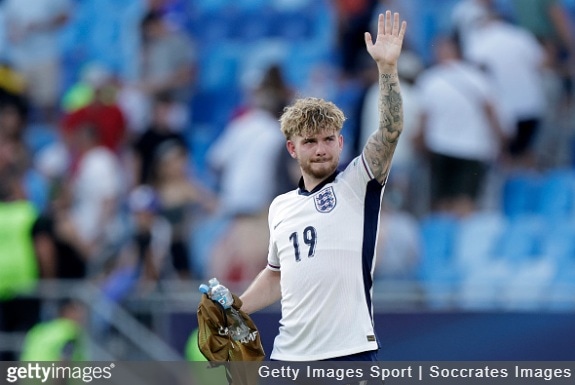In the European Under-21 Championship held in Slovakia, Harvey Elliott stood out as England’s key player during the knockout phase. The 22-year-old Liverpool midfielder netted four goals in the tournament, scoring his second in the 3-1 quarter-final victory over Spain. His impressive form continued with two goals in the semi-finals against the Netherlands, significantly contributing to England’s progression to the final against Germany and establishing him as a strong candidate for the Tournament Awards Player Award.
Upon returning to Merseyside, Elliott faces uncertainty regarding his future at Liverpool. Despite making 28 appearances across all competitions in the last few seasons, he has only been a starter six times—once in the Champions League after qualification was secured and once in a domestic Cup match following the Premier League title win. Most of his appearances have been as a substitute.
Even though his playing time has been limited, Elliott’s statistics over the past year are notably impressive when assessed per 90 minutes. He averages 0.66 goals, an expected goal (XG) of 0.4, 3.49 shots, 0.33 assists, an expected assist (XA) of 0.18, and an average of 8.8 progressive carries. These figures point to his potential, especially given that he has played in the Premier League 94 times, making him an appealing prospect for his club.
However, Elliott’s position at Liverpool is complicated by tactical considerations and positional overcrowding. New head coach Arne Slot has yet to define a specific role for him. Although he can play as a right winger, attacking midfielder (No. 10), or center midfielder (No. 8), none of these positions are straightforward in Liverpool’s current setup. The team does not typically position a traditional No. 10—a central attacking midfielder. While Elliott has often been positioned on the right wing, he significantly differs from Mohamed Salah, the player he would replace.
Salah remains the preferred choice for the starting XI, offering a direct, physical playing style that thrives in one-on-one situations and exploits space behind defenders. In contrast, Elliott gravitates toward linking plays and acting as a classic playmaker, benefiting from overlapping full-backs for width, particularly when playing for England alongside Tino Livramento.
Elliott excels in setups like Lee Carsley’s England U21 squad, which allows him to operate in half-spaces as a creative influence. In this role, he shines with his energy, intelligent movement, dribbling, and precise shooting. However, adapting these strengths to Liverpool’s high-energy style, which emphasizes pressing and quick transitions, remains a challenge.
The physical demands of playing in midfield heighten the difficulties for Elliott. Liverpool’s counter-attacking system relies heavily on pace, stamina, and defense against rapid transitions. Despite his efforts to fulfill defensive responsibilities, Elliott’s smaller build and lower top speed make him less suited for that role compared to his teammates. He notably made a significant contribution to Darwin Núñez’s goal when supporting Alexis Mac Allister in their January victory.
These tactical and physical factors have influenced Liverpool’s recruitment approach in recent years. After defensive struggles when Elliott played more regularly in midfield during the 2022-23 season, the club reassessed its options, opting not to pursue Jude Bellingham but instead seeking players who meet its tactical requirements.
Currently, Elliott finds himself behind several midfielders in the lineup. The recent acquisition of Florian Wirtz for a potential fee of £116 million adds to the competition. Alongside Wirtz, Liverpool has Dominik Szoboszlai, Mac Allister, Ryan Gravenberch, and Curtis Jones in similar roles, creating a bottleneck that reduces Elliott’s chances of securing regular minutes, especially in his preferred advanced position.
Nonetheless, Elliott’s per-90 statistics indicate his significant potential—perhaps better suited for a different environment. While few Premier League clubs could accommodate Liverpool’s valuation, leagues like La Liga or Serie A may provide the ideal setting for him to thrive as a central figure, allowing his creativity to shape offensive strategies.
For now, Liverpool faces a decision: should they build a role around Elliott’s talent and statistics, or would it be better for both parties to consider a transfer? The upcoming summer transfer window, along with Elliott’s choice, will ultimately determine whether he can find a tactical environment where his skills can consistently shine.
Fan Take: This news is significant for soccer fans as it highlights Elliott’s immense potential and raises questions about tactical fit in elite clubs. His journey could reshape discussions on how young talents develop within high-press environments, influencing future recruitment strategies across the league.



